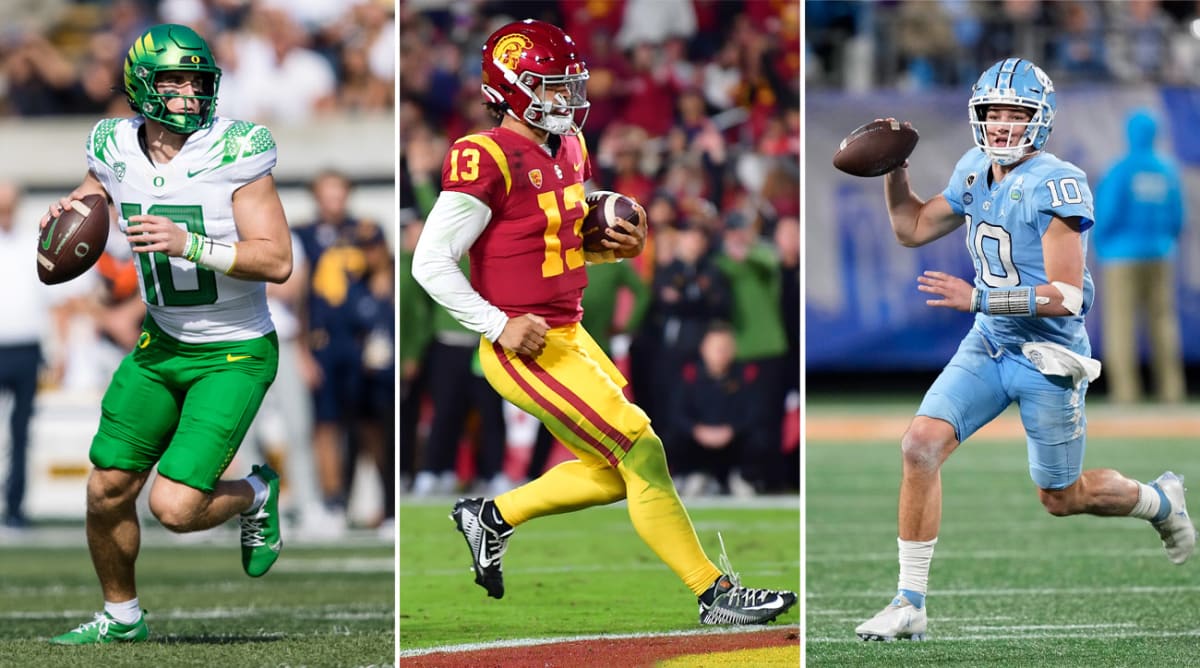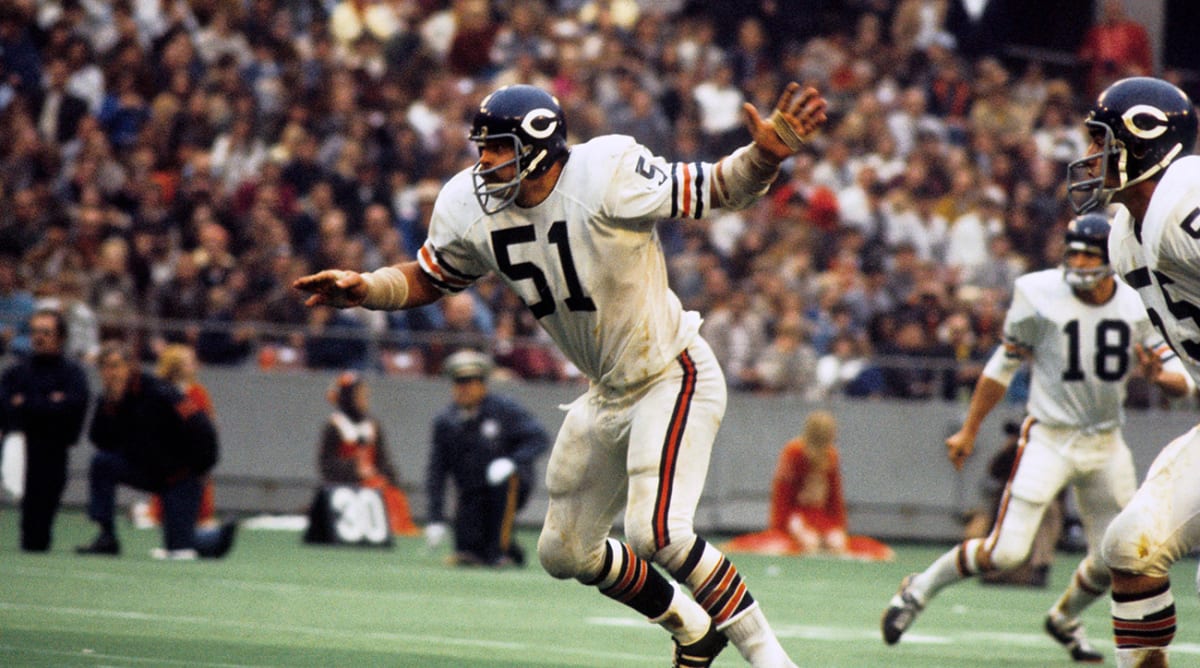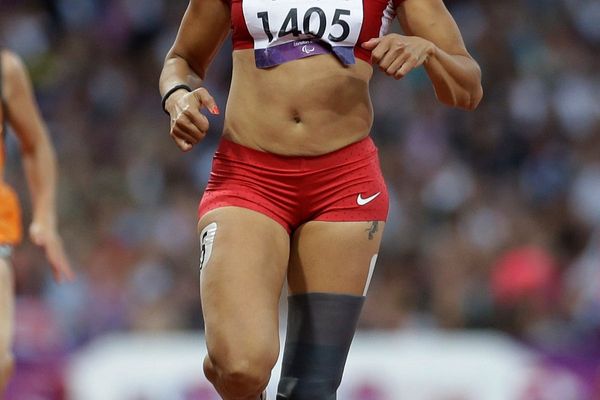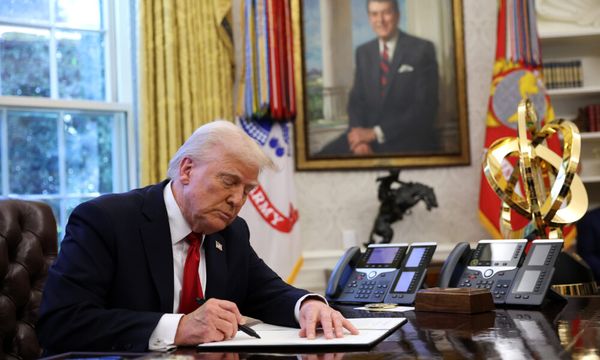Week 5 of the regular-season schedule is here, and the season is rolling . . .
• Caleb Williams goes No. 1, Drake Maye goes No. 2—and we’re just getting started.
For months and months, we’ve known USC’s Heisman winner and North Carolina’s athletic gunslinger were lining up as the first- and second-best quarterback prospects, if not the best prospects, in the 2024 NFL draft class. What we didn’t know a few months ago was how things would play out with the rest of a very promising quarterback group, full of players with potential and plenty left to prove.
Well, it’s October, and if the first five weeks of the college season are any indicator, it could be a very good year to need a quarterback in April.
Earlier this week, I polled a handful of execs and college scouting directors to ask which quarterbacks not named Caleb or Drake had helped themselves and maybe entered the first-round discussion, to this point. No fewer than six names were raised—Oregon’s Bo Nix, Washington’s Michael Penix, Michigan’s J.J. McCarthy, Texas’s Quinn Ewers, Colorado’s Shedeur Sanders and Duke’s Riley Leonard were those six.

John Hefti/USA TODAY Sports (left); Gary A. Vasquez/USA TODAY Sports (center); Jim Dedmon/USA TODAY Sports (right)
Nix is one we addressed in the mailbag Wednesday, and one whom multiple evaluators raised to me. “Athletic, competitive, solid arm, improved accuracy and overall passing,” says an AFC exec. “He’s competitive with playmaking instincts.” It’s also helped that his production hasn’t just held up, it’s improved, with former Oregon offensive coordinator Kenny Dillingham (who was credited with Nix’s post-Auburn uptick last year) now gone.
Another exec, this one from an NFC team, agreed that Nix could go in the first round, and then added he believed McCarthy would go before him—“He’s got a lot of the quarterback traits you want. Tough, accurate, smart, instinctive. Calm in the pocket. Can run and hurt you with his legs. I think his arm strength is probably just slightly above average, but it’s not an issue.”
A third, from an NFC team, picked Leonard and Sanders as his two. “Leonard’s a big, mobile, athletic guy who can spin it—very good toughness and leadership, with big upside,” he says. “And Sanders has proved he can do it vs. top competition now. He’s extremely tough, has a good arm and pocket awareness. He just needs to understand he can’t extend play to the point where he takes so many hits and sacks. But that can be coached.”
And then there’s Penix, who has been the most productive of any of them—“He still needs to prove he can make real throws against good defenses, but the productivity is there,” says an AFC college scout. And Ewers has been more efficient this year, erasing questions that lingered after his transfer from Ohio State.
Will all eight of these guys go in the first round? Of course not. But having this many names in the mix is exciting and should give fans of bad NFL teams (and really all NFL fans) really cool stuff to follow for the rest of the fall.
• A leftover from my Bills reporting last weekend—I asked Sean McDermott whether the Bills did anything different (or special) to slow down the supersonic Miami offense Sunday.
His response: “[The players] really just executed. They executed our defense. It wasn’t [the] game plan. I’d like to say it was, but they really buckled down after the first couple series there and executed our game plan and played fundamentally really strong football.”
Sounds like coachspeak, but after talking to some folks who studied the game in the days to follow, there really wasn’t anything out of the norm that the Bills did schematically.
This boiled down to the Bills being able to get on top of the Dolphins, create some negative plays and take Miami out of its comfort zone. Remember, Miami didn’t face a third down of more than four yards to go until its seventh touchdown drive against Denver.
Stuck in more obvious passing situations, the Bills were able to stay in nickel personnel and a two-shell coverage look for most of the game after they built a sizable lead. They were more physical than the Dolphins, they were able to turn up the pass rush and get heat on Tua Tagovailoa and they asserted themselves as the team to beat in the AFC East.
So was there a blueprint drawn? Sure. If you have Josh Allen at quarterback to build a massive lead, then that’s your blueprint.
• It was hard not to see the juxtaposition of the Bears’ two big receiver acquisitions Thursday night. One was going for 230 yards and three touchdowns on eight catches, helping Justin Fields maintain his perfect passer rating throwing to Moore this year. The other was not just a healthy scratch, but told to stay away from the team, with his GM saying before the game, “I wish him luck moving forward” hours before he was traded to the Dolphins.
The former, of course, is DJ Moore. The latter is Chase Claypool. And the lesson here, I believe, is straightforward.
Claypool was acquired at the trade deadline in 2022, when the market was, by definition, limited. He was one of four receivers moved, and all were damaged goods, having fallen out of favor with their teams for a variety of reasons (Kadarius Toney, Chosen Anderson and Calvin Ridley were the others). Ridley has worked out, but the Jaguars had to wait until this year to get anything tangible out of that deal because of Ridley’s gambling suspension. And Toney has been O.K., making big plays in the Chiefs’ Super Bowl win over the Eagles.
The bottom line is a lot of teams were looking for receiver help, and demand far outweighed supply, which is why the cost for the mercurial Claypool (the 32nd pick) actually would be close to what the price was for Amari Cooper (the 27th pick) at the deadline in 2018. The Steelers, for what it’s worth, wound up getting Joey Porter Jr., who’s in their corner rotation as a rookie with that pick.
Moore, on the other hand, was dealt as part of a larger deal with the Panthers in the offseason with teams having more options to upgrade the position at their fingertips. Moore was basically slotted in, by value, as the third first-round pick the Panthers would give up to land the first pick, which became Bryce Young.
All of this, of course, will be good to consider as we get closer to this year’s Oct. 31 trade deadline.
• I hope people take a look at what Jets center Connor McGovern told ESPN’s Rich Cimini about Nathaniel Hackett’s looming return to Denver this week.
“He got thrown under the bus—and then they tried to drag him under the bus,” McGovern said. “We wanted to rally around him from the start. He’s such a good guy. I don’t know how you want to say this, the opportunity he has, but we want to make the most of him being our play-caller.
“He’s a phenomenal coach, crazy smart, and he makes meetings really fun and easy to learn. So he’s definitely a guy that you want to play hard for. Then to go to a place that was dogging a guy that’s so nice and so good at his job, and for him to get thrown under the bus and dragged through the mud, you definitely want to play that much harder.”
For the beating that Hackett’s taken over the past 12 months, as McGovern said, he’s still a really good coach and a really good guy. I’d bet that’ll show over the next three months as he makes it work without Aaron Rodgers and builds an offense for Zach Wilson.
• For all the acrimony over the past couple months, I’m told the Colts were really impressed with how hard Jonathan Taylor worked over the past few weeks to have himself in the right place to jump back in the lineup this week. And getting the old Taylor back would benefit everyone.
It sets Taylor up for the payday he’s been seeking. It also will help the Colts with Anthony Richardson, as part of an already productive run game, and could lead to enticing trade offers coming in over the next few weeks. And I think for Shane Steichen, who was thrust into a very difficult situation for a first-year coach, he’ll have the opportunity to show everyone in the locker room that he’ll do right by a guy who’s been an excellent player, worker, teammate and person since he arrived in Indianapolis in 2020.
• In the whole turf-vs.-grass debate, the “slit film” form of synthetic surface has come under scrutiny from players and the union. And so, over the next two weeks, it’s something to watch with the NFL staging games at Tottenham Hotspur Stadium in London. A league investment has led to the installation of football-specific fixings in the new venue.
Vikings safety Lewis Cine suffered a compound fracture in his left leg on the field last year—an injury serious enough that he had to stay behind in London to have surgery while his teammates returned to the states. Cine later called the surface “sketchy.”
Last year’s Jaguars-Falcons game was played at Wembley, which has a grass field. The Jags play the Bills at Tottenham this week, with the Ravens and Titans there next week.
• When Patriots coach Bill Belichick says something like this—“Jordan is one of the players I have the most respect for in the league”—I pay attention. “Jordan,” of course, is Cam Jordan, the Saints’ venerable 12th-year defensive end who is up to 116 sacks, and may have a pretty good Hall of Fame case when all is said and done.
• Give the Cowboys credit for being prepared for injuries. DaRon Bland had a fantastic game (pick-six, and nearly a second pick that could’ve gone the distance) against New England last week in Trevon Diggs’s old spot, and Dallas had enough depth at left tackle, with journeyman Chuma Edoga, to where they didn’t have to move left guard Tyler Smith back outside to take Tyron Smith’s place.

Herb Weitman/USA TODAY Sports
• RIP, Dick Butkus. I think if I’d asked my dad when I was a kid what a football player was, he’d have shown me a picture of the Bears legend. That’s the kind of tough-guy legacy he had, and the mark he left on the sport. Here’s hoping peace for his friends and family, and a chance to celebrate a life well lived.
• The NFL declaring the Taylor Swift–Travis Kelce, uh, situation a “pop culture moment” is pretty hilarious. Because that’s very much what they wanted to make it over the past week, and, I’d bet, crafted in very important closed-door meetings. Clearly, the league wanted in on the popularity of Swift’s Eras Tour. And this, I guess, was the way to do it.







